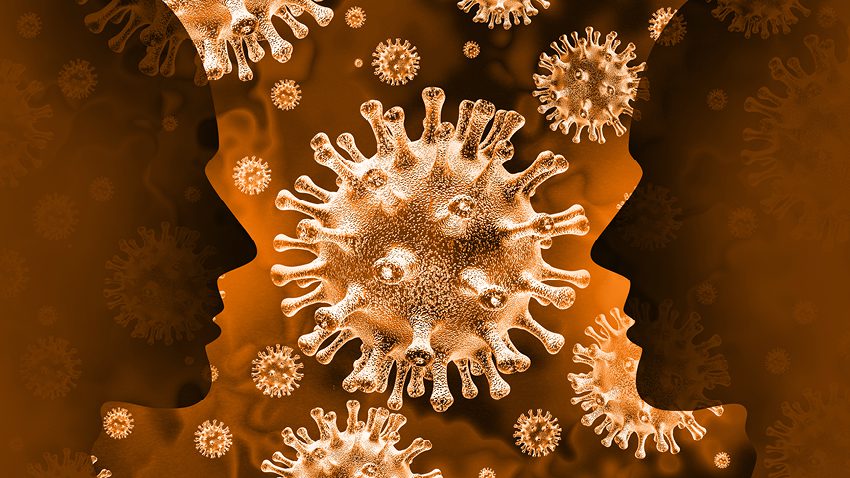“All that you touch you change. All that you change, changes you. The only lasting truth is change”, author and futurist Octavia E. Butler wrote.
An apt quotation as the world grapples with a never ending series of COVID-19 viral variants. Since the virus first emerged from China in December 2019, it has spread across the world. And in its spread, it has mutated repeatedly. But to understand why COVID-19 has mutated like it has, we must understand the basics of viral mutations.
COVID-19 is an RNA based virus. These types of viruses mutate at a faster rate than their DNA based counterparts. Mutations occur over infection cycles, a term infectious disease experts use to describe the life cycle of a viral infection, in which the virus enters a host, replicates inside, and then spreads from the host to others.
A study out of Portugal found the rate of spontaneous mutation in COVID-19, or more formally, SARS-CoV-2, is 0.1 per genome per infection cycle, slower than most RNA viruses. But just 10 months after COVID-19 was first discovered, researchers out of Duke University catalogued more than 12,000 mutations.
At first it may appear odd that a virus with a slow mutation rate has so many mutations, many of which make the virus more infectious. But oddly enough, it makes perfect sense, because there is a difference between the frequency of individual mutations, and the total mutations seen.
Infectious disease specialists differentiate mutation frequency as the proportion of mutations in a population, and mutation rate as the rate at which mutations occur in a viral genome.
COVID-19 has spread across the world in a year, an unprecedented reach for a novel virus. In its spread, it incurred numerous infection cycles, giving it plenty of opportunities to mutate.
And mutate it has, though at a much slower rate than when it first appeared. Most of the variants we are now learning about through the news cycles were discovered months ago.
According to the WHO database on COVID-19 virus variants, the delta variant was discovered in India in October 2020 and the lambda variant was discovered in Peru in August 2020. In fact, the WHO documented the latest variant, theta, in January 2021. No additional variants have been discovered since.
This bodes well for a global population that struggles to distribute its vaccines and unable to shake off its lingering vaccine hesitancy.
“This variant now is the pandemic. As a result, its properties matter,” wrote Nathan Grubaugh, a viral epidemiologist at the Yale School of Public Health.
This means the course of the pandemic hinges on the rate of COVID-19 mutations.
Most of the mutations have produced variants that are more infectious, a lucky break we may lose if the mutations result in variants resistant to the acquired immunity derived from vaccines.
Regardless of whether we are vaccinated or symptomatic, when we come in contact with another person, we give the virus an opportunity to spread – and mutate – as it spreads through an infection cycle.
Studies suggest the viral mutations have optimized its infectivity rates, but it can still mutate to be resistant to available treatments.
While we have quickly developed treatments, therapeutics, and vaccines to combat the symptoms produced by the virus, we have nothing to stop the transmission of the virus or its ability to mutate.
In July 2021, researchers in Germany published data on six immunocompromised patients with COVID-19 who were treated with monoclonal antibodies. In five of them, the virus acquired a mutation known for eluding the immune system, and the virus rebounded in all five patients.
There is no definite treatment for COVID-19. It is a virus. The only treatment is to control the symptoms of the disease to where we can live normal lives.
That means balancing the viral mutations with the available treatments and vaccines.
We seem to be edging out the virus in this regard. But like all things related to COVID-19, the battle is evolving, and will be won through a shift in perception more than any scientific breakthrough.
We may need to accept localized lockdowns and mask-wearing and social distancing as a part of our everyday lives for the foreseeable future. That may mean for us to accept public health policies even when the virus appears to be gone or diminished.
This would be a change.
We must recognize that the cure for COVID-19 is not some drug or complex immunomodulation therapy. The treatment has nothing to do with technology and everything to do with simple behavioral changes that we are all capable of.
This would be a change.
At a fundamental level, a mutation is nothing more than a change. The virus changes every time it comes in contact with anyone of us. We must also learn to change.
That is the only treatment.















